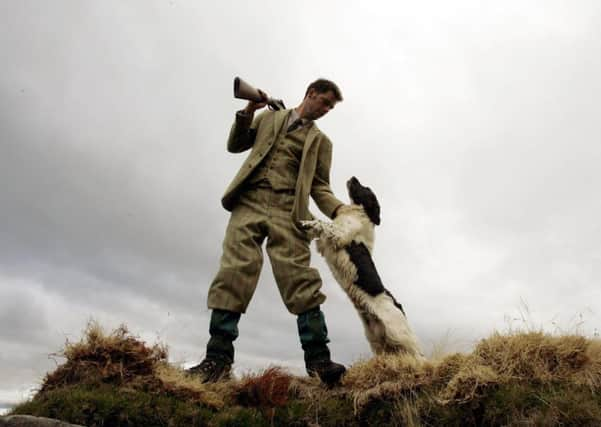Petition to end tail docking ban taken to Holyrood


Gamekeepers handed over a 4,000-strong petition to rural affairs secretary Richard Lochhead yesterday. The MSP said the government will now consider “revisiting” the ban. It follows new research which found more than half of working spaniels suffered tail injuries during the 2011-12 shooting season.
Injuries occur as dogs scamper through undergrowth to flush out grouse and pheasants, and their longer tails mean they stand a greater chance of injury.
Advertisement
Hide AdAdvertisement
Hide AdThe Scottish Gamekeepers Association (SGA) says Alex Salmond must fulfil a promise made to ditch the ban if it proved harmful to animals.
Chairman Alex Hogg said: “We fully agree dogs’ tails should not be docked for cosmetic reasons but working dogs, by nature, are different and every other UK country has recognised this except Scotland.
“Alex Salmond promised at our AGM seven years ago that any government he led would reverse this ban, if there was evidence to do so. He said his government would stand up for rural Scotland, and that gave people hope.”
The SGA says research by Glasgow University, to be published in the coming weeks, shows that almost 57 per cent of all working spaniels suffered tail injuries in 2010-11, while 38 per cent of hunt point retrievers suffered the same fate. The researchers surveyed 2,860 working dogs.
Prior to the ban, it was legal to dock the tails of working pups at two or three days old to prevent injuries in later life.
Tail-docking was banned in 2007 amid concerns over the welfare of the animals and can be punishable by a jail term of up to six months. In England, Wales and Northern Ireland, where docking is also illegal, exemptions were made for working dogs.
Vet George Greig, a partner in a leading Scottish veterinary practice, believes the legislation has been disastrous for working breeds.
“It’s morally indefensible. From my experience, one in three dogs that suffer tail damage suffer a further breakdown before the decision is finally taken to amputate. The suffering is, therefore, prolonged. On the other hand, I’ve docked thousands of puppies and it is nothing. It is a little snip and the pups barely notice it whereas, in an adult dog, it is major surgery. If a dog is going to work, it needs a shorter tail, end of story.”
Advertisement
Hide AdAdvertisement
Hide AdAfter receiving the petition from campaigners outside Holyrood, Mr Lochhead said: “Clearly the government has the option of revisiting the legislation and the exemptions, and that is why we commissioned the research, so that any decision that is taken is evidence-based.”
Mr Lochhead said the research on tail docking is expected to be published in the next few weeks. The government will then invite comment from interested groups.
COMMENT
Alastair Robertson: Docking working dogs is a matter of common sense, rather than one of taste
For many, it was the mutilation of an animal for cosmetic reasons. For the owners of working dogs, it was a sensible precaution against injury.
Nothing divided town and country in Scotland so much as the ban on tail docking, introduced by the 2006 Labour/Lib Dem coalition at Holyrood.
On the face of it, the ban made some sort of sense. To the question of whether a civilised country should allow dogs to have their tails chopped off to satisfy the whim of some outdated fashion, the answer was clearly no. But in their eagerness to curry favour with animal rights lobbyists and anti-field sports activists, the coalition failed to spot the devil in the detail. Or simply ignored it, believing the bulk of Labour’s urban heartland voters could not have cared less.
Tail docking among non-working breeds that were once hunting dogs was clearly pointless and simply a matter of fashion. But when it came to spaniels, terriers and hunter pointer retrievers – which had to work among thick undergrowth heather and bracken – an undocked tail was an invitation to painful injury.
But it was impossible to demonstrate that undocked dogs faced injury for the very good reason that working dogs were all docked.
Advertisement
Hide AdAdvertisement
Hide AdIn England, provided they are of a recognised working breed, dogs are allowed to be docked.
Here, most owners have simply left puppy tails intact, and survey after survey has shown a rise in working dog tail injuries and amputations.
What the ban may have achieved, however, is making everyone realise docking (undoubtedly being carried out illegally) need not be a matter of leaving an unsightly stump where a tail once wagged.
Simply snipping off the last two to three inches at birth ensures a massive reduction in whip lash injuries. It’s not mutilation. It’s common sense.
• Alastair Robertson is The Scotsman’s shooting and fishing correspondent